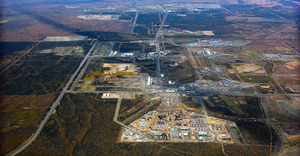Michigan State University Anaerobic Digestion Project Takes a New Leap
Michigan State University’s anaerobic digester, developed by Anaergia, is undergoing a major upgrade to handle increased organic waste and support the new Dairy Cattle Teaching and Research Center. The expansion will quadruple the facility's capacity by 2026, showcasing a scalable model for sustainable waste management and emissions reduction on university campuses.

A decade after building Michigan State University’s (MSU) anaerobic digester, followed by several expansions, project developer Anaergia is taking the learning institution’s facility up another notch.
One of the largest university digesters in the country, the plant processes manure and food waste, providing a sustainable outlet for MSU’s waste streams as well as for some of the community’s organic material. This newest upgrade and expansion will enable the school to more broadly serve the community and accommodate its soon-to-launch Dairy Cattle Teaching and Research Center. The Center will host 680 dairy cows.
What’s striking about this particular project—one of many in the tech developer’s portfolio— is that it demonstrates circularity and a way to reduce emissions on a university campus at scale, says Yaniv Scherson, Anaergia COO.
“Providing organics recycling, renewable energy, and heat on a campus with 51,000 students and more than 12,000 faculty and support staff is significant. And this is a repeatable model for other universities, who, like large institutions in general, face challenges in managing their organic waste and reducing their carbon footprint while meeting their energy needs,” Scherson says.
By the end of 2026, with pending upgrades, MSU’s system will be able to handle about 30,000 gallons of dairy waste and 40,000 gallons of food waste per day, roughly quadrupling its capacity since 2013.
The MSU operation is one of over 200 plants that Anaergia has built across the world in the last 10 years. A few standout projects are a facility in South Africa for a Pepsi food production operation; Japan’s largest manure digester; and North America’s largest food waste digester, located in Southern California.
Key to efficiency is the ability to mix well in very large tanks. Anaergia engineered its mixing technology to be able to build mega plants with high throughput as well as to substantially bump processing and cost efficiency for operations with small footprints. While many of these projects have come up off the ground from scratch, some of them are retrofits to existing facilities, often tripling their throughput, according to Scherson.
The systems are modular, built to the size and with the combination of features that meet each customer’s needs. They can integrate solid waste processing and wastewater treatment with organics recovery to produce multiple end products, from renewable power to fertilizer.
Customized systems may incorporate technology that upgrades biogas to renewable natural gas; technology to meet sewer discharge limits; and degritting systems to clean feedstock before it’s fed into the digester; among add-on components.
But what’s the same with every project Scherson says is the fundamental design concept: an integrated technology platform that delivers turnkey plants that manage material from feedstock to fuel.
As demand heightens for ways to handle greater volumes and types of organics, more feedstocks are coming into these systems. Operators often work with a combination of manures and food wastes, or they may manage mixes of food wastes— fats, oil, and grease and animal byproducts, among materials that flow into one central plant from what could be dozens of suppliers. So, feedstock chemistries are complex and varied.
“It takes a well-designed plant with the right equipment and process design, and it takes good operations and monitoring to run stable and be effective.
“We remotely monitor plants, run lab analytics, and we train our operators to maintain digesters to make sure they are running healthy with no upsets,” Scherson says.
Anaergia targets three market segments: municipal wastewater treatment plants, agricultural producers, and industrial customers (like MSU and Pepsi).
The opportunity and interest are there. Food waste generators are beginning to see digestion as another option to deal with their waste, feeling pressure as states enact policies calling on them to divert more from landfill. Farmers are finding they can effectively manage manure and associated odors through digestion and ultimately end up with an end product: fertilizer. And Scherson has seen interest especially growing among municipal wastewater operators; this sector is investing in upgrades to existing infrastructure and sometimes building new to manage intensifying loads, and in answer to the issue of water scarcity, which is becoming a center climate focus.
As these stakeholders bring more business to companies like Anaergia, Scherson says the team is having conversations with more universities who are paying attention to the “MSUs” out there.
The Michigan facility converts food waste from campus dining halls, manure from the university’s dairy farm, and food processing waste from the local community into 380 kW of electricity, which powers some of the buildings on campus. But MSU has made this investment as much in the interest of advancing research and learning.
“The digestion facility provides valuable opportunities for students interested in environmental issues to gain hands-on experience with cutting-edge technologies,” says Wei Liao, professor and director Anaerobic Digestion Research and Education Center, Department of Biosystems & Agricultural Engineering Michigan State University.
“Additionally, MSU researchers utilize the facility to advance studies in renewable energy, wastewater treatment, and climate change, driving innovation and contributing to global environmental solutions,” Liao says.
He sees this project as more than a means to make progress toward the university’s most fundamental goals.
“While the updated [system] serves as a cutting-edge testbed for developing and refining anaerobic digestion technologies, which is crucial for advancing our teaching and research missions, it also is crucial for promoting the sustainable development of rural communities.”
About the Author
You May Also Like




